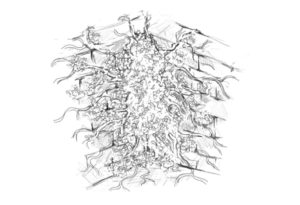He waits for his victim in caves, becoming similar to invisible plants. It is stuck and sometimes even embedded in walls. The way of growing it is reminiscent of grapes, it twines the surrounding areas with its branches. They appear singly. If two clowns meet on the same wall, they will start fighting for territory, releasing venom on the opponent.

Life Cycle: Drained, the seeds find dark and damp places on the body of the carrier (victim that has fled) and settle there. It develops taking small roots for about 15 hours. After this time, it suddenly starts to grow and in 2 hours it is several meters wide. Adheres to any surrounding wall or object. When it covers about 2 m of the surface, it becomes aggressive and behaves like an adult. If it is not fed, it dries up after 20 days and falls off by itself. It mainly eats meat and the warmth of its victim. Already 250 grams of meat will satisfy the nutritional needs for 20 days. That is why the hunted victim may keep for several years and constantly, slowly feed on it. Naturally, it can live for several hundred years.
It looks like seaweed or grapes growing on the wall. It adapts to the environment by changing its temperature and color so that the victim neither feels it nor sees it. Combat: He can attack in two ways, depending on his intention. In order to scare another, the clown moves slowly and spits venom that dissolves living tissue. Surprise is its main asset when hunting. It waits for the victim to approach him and attacks very quickly, grabbing it with its roots-like legs. He holds it in the air and pollinates it with very small seeds. If the victim fails to free himself, he presses against the wall and slowly devours his legs with all his legs, dissolving and absorbing by small, expanded absorbers. If the victim breaks free, the unknowingly spreads the seeds and is likely to carry them to their nest or home where there are more potential victims.